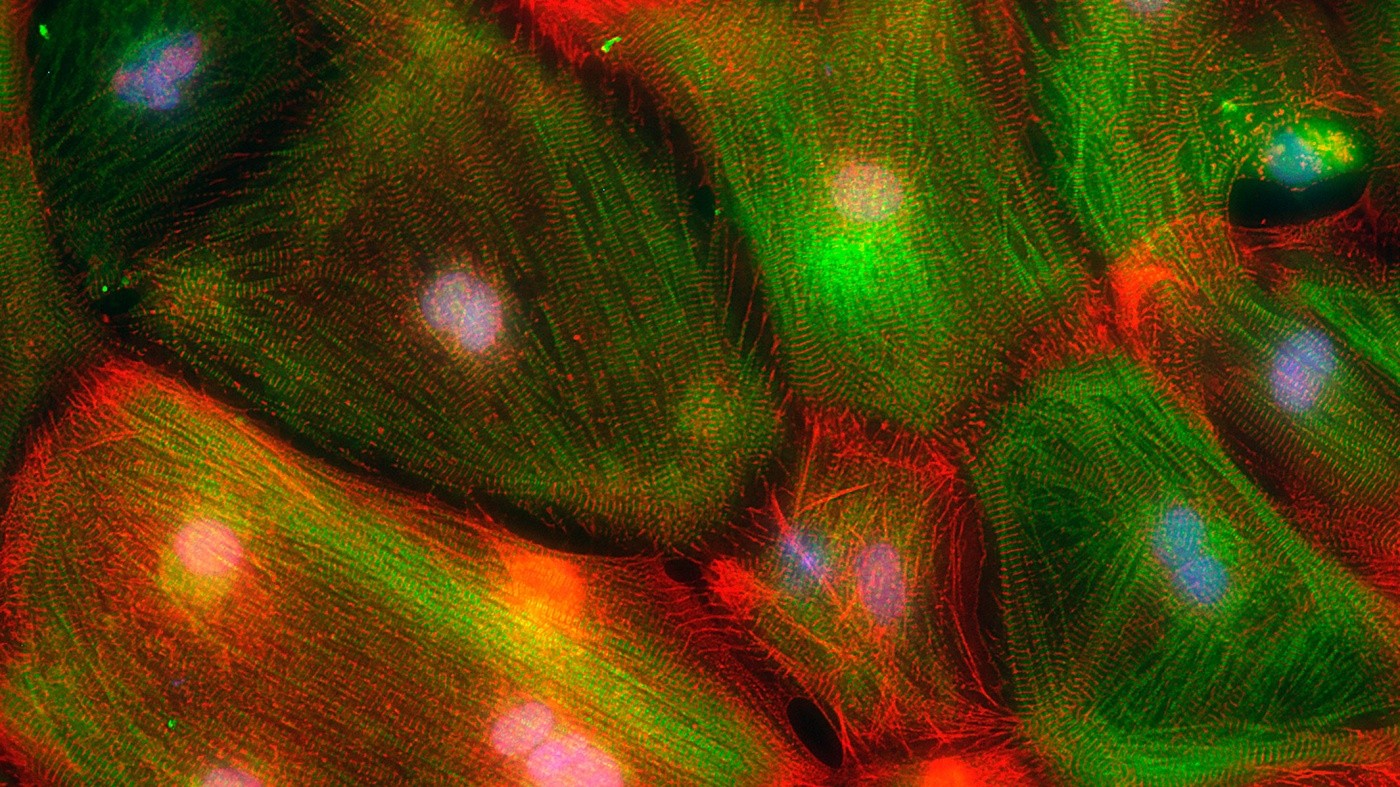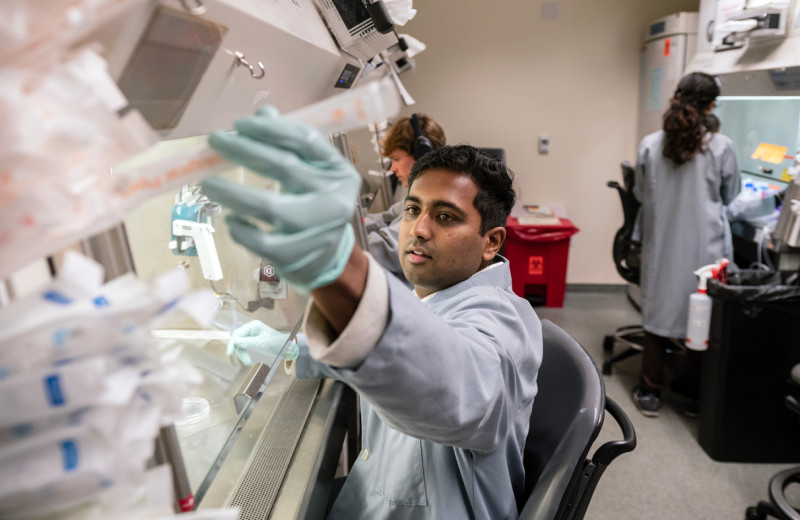Gladstone NOW: The Campaign Join Us on the Journey✕

CRISPR makes it possible to target, study, and hack DNA in the search for cures. These heart cells were created from stem cells and manipulated using CRISPRi. [Image: Mohammadali Mandegar, Gladstone Institutes]
The pace of science is accelerating. In the past, research methods remained the same for decades. Now, a new technology emerges every few years that disrupts the status quo of biological science. The most recent breakthrough is CRISPR—a tool to edit the genome of a human cell more precisely and efficiently than ever before.
CRISPR has enormous potential to cure intractable diseases. At the Gladstone Institutes, scientists are using the technology to advance scientific knowledge and pursue new therapies for heart disease, HIV, dementia, blindness, and more. With CRISPR, they have improved research methods and developed better models of genetic disorders. They are also embarking on a precision medicine approach to treat these debilitating conditions.
“CRISPR is a real game-changer. It is a huge jump forward from previous genome editing techniques,” said Gladstone Senior Investigator Bruce Conklin, MD, an early adopter of the technology. “With CRISPR, we can accomplish research that we never before thought possible.”
What is CRISPR?
At its most basic, CRISPR, or Clustered Regularly Interspaced Short Palindromic Repeats, is a string of RNA. When introduced into a cell, the RNA seeks an identical series of letters in the DNA of the cell. Scientists can design the precise letter sequence they want to target, and use CRISPR to home in on that specific part of the genome. The technique enables researchers to pinpoint a single series of letters out of the three billion that make up human DNA.
The researchers can then manipulate this string of letters—exchange, silence, or delete them—with a variety of methods. The most common technique involves an enzyme called Cas9 that is attached to the CRISPR guide RNA and cuts the DNA at the designated site, removing the letters. The DNA then fuses back together, either without the letters or with a new string the scientists insert. Both methods change the cell’s DNA and alter the identity of the target gene, which ultimately modifies the cell’s behavior.
Precision Medicine Through CRISPR
CRISPR has already advanced knowledge about human biology and pathology. For example, scientists are learning how individual genes control organ development or disease. With CRISPR, researchers can edit a single gene in healthy cells and compare them to unchanged cells from the same source. Any differences that develop between the two groups of otherwise identical cells can only be due to the edited gene.
Conklin’s laboratory uses this process to probe the genetic origins of cardiomyopathy, disease of the heart muscle. His goal is to use precision medicine to treat cardiomyopathy, matching a patient’s therapy to their genetic mutation.
Cardiomyopathy can be caused by a single mutation in any one of a number of genes, each one resulting in a slightly different variant of the disease. However, which mutation corresponds to which form of the disease is still unknown. By studying specific mutations, researchers can determine how each one contributes to cardiomyopathy, with the goal of identifying and developing drugs that treat the different variants of the disease. With this approach, patients could one day receive personalized therapies for the specific gene mutation that causes their form of the disease.
Using a similar technique, Cindy Huang, PhD, a postdoctoral scholar in the laboratory of Li Gan, PhD, uses CRISPR to study the genetic basis of frontotemporal dementia. Huang creates disease-causing mutations in the tau gene of healthy neurons and charts how the cells respond.
“Currently, there is not a systematic way to study the different mutations in the tau gene that cause frontotemporal dementia,” said Huang. “With CRISPR, we can track the disease progression related to each mutation. This will help us understand the different ways tau is disrupted in dementia and potentially create new therapies to fix these changes to the protein.”
Improving CRISPR Efficiency and Flexibility
While CRISPR is better than previous genome editing methods, there is always room for improvement. Gladstone scientists are working to enhance CRISPR and develop the next version of the technology.
Chen Yu, PhD, a postdoctoral scholar in the laboratory of Sheng Ding, PhD, discovered how to boost the efficiency of CRISPR-mediated genome editing with a few key chemicals. He identified two compounds that significantly improved scientists’ ability to insert new genetic code into a cell’s DNA after it is cut by Cas9.
“Currently, CRISPR is very effective at deleting genes, but it less efficient when you want to replace one string of letters with another,” said Yu. “We improved the CRISPR-Cas9 system by introducing small molecules that can maintain its precision at locating a point on the genome to cut, while boosting intrinsic repair mechanisms that fuse the DNA back together.”
Other Gladstone scientists are exploring a recently developed reversible form of CRISPR that provides greater flexibility. Mohammadali Mandegar, DPhil, a postdoctoral scholar in the Conklin laboratory, uses CRISPR interference (CRISPRi) to modify gene expression in induced pluripotent stem cells temporarily.
CRISPRi uses an inactive or “dead” form of Cas9 that latches onto the targeted stretch of DNA but does not cut it. The addition of a specific chemical to the cell activates the Cas-9 to suppress the identified gene. When the scientist removes the chemical, the gene is no longer inhibited.
“CRISPRi acts like an on-off switch, so we can reverse gene suppression by simply removing the chemical inhibitor,” said Mandegar. “By changing the amount of the chemical, we can also tune how much a gene is silenced. This flexibility gives us more versatility when creating cellular models of disease and development.”
Cutting-Edge Technology Enables Cutting-Edge Research
Emerging research methods fuel scientific progress and accelerate the pace of discoveries. As the latest technological development, CRISPR has expanded the type of questions scientists can ask and provided better ways to answer them.
Gladstone scientists use and improve on each new generation of technology, pushing the boundaries of scientific innovation to study disease. Using ingenious tools such as CRISPR, they will expedite the discovery of new treatments for devastating diseases.
The Genome Editing Playbook Is Different in Neurons
The Genome Editing Playbook Is Different in Neurons
The striking findings of a new study could influence how gene therapies are designed for many genetic diseases.
News Release Research (Publication) Neurological Disease Conklin Lab Doudna Lab CRISPR/Gene EditingCIRM Awards $7.5 Million in Discovery Grants to Gladstone Investigators
CIRM Awards $7.5 Million in Discovery Grants to Gladstone Investigators
Two ambitious research projects led by Gladstone investigators are boosted by funds from the California Institute for Regenerative Medicine.
Grants News Release Congenital Heart Disease Cardiovascular Disease Bruneau Lab Conklin Lab CRISPR/Gene Editing Human Genetics Regenerative MedicineScience in Seconds | Gladstone Researchers Tackle Charcot-Marie-Tooth (CMT) Disease
Science in Seconds | Gladstone Researchers Tackle Charcot-Marie-Tooth (CMT) Disease
Bruce Conklin and his team at Gladstone are tackling Charcot-Marie-Tooth (CMT) disease, the most common inherited neurological disorders—for which there is currently no cure.
Gladstone Experts Conklin Lab CRISPR/Gene Editing



